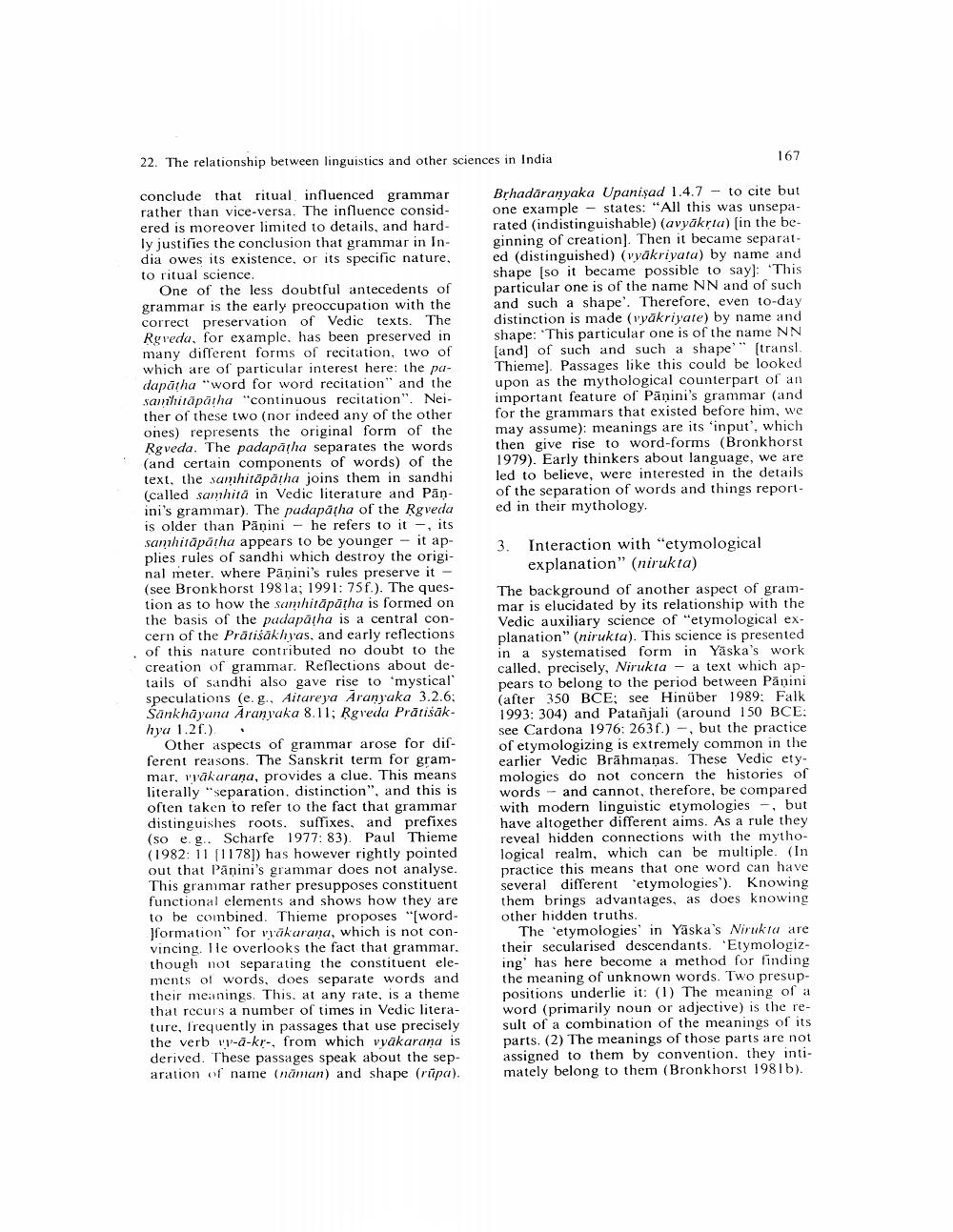Book Title: Relationship Between Linguistics And Other Sciences In India Author(s): Johannes Bronkhorst Publisher: Johannes Bronkhorst View full book textPage 2
________________ 22. The relationship between linguistics and other sciences in India conclude that ritual influenced grammar rather than vice-versa. The influence considered is moreover limited to details, and hardly justifies the conclusion that grammar in India owes its existence, or its specific nature, to ritual science. One of the less doubtful antecedents of grammar is the early preoccupation with the correct preservation of Vedic texts. The Rgveda, for example. has been preserved in many different forms of recitation, two of which are of particular interest here: the padapatha "word for word recitation" and the samhitapatha "continuous recitation". Neither of these two (nor indeed any of the other ones) represents the original form of the Rgveda. The padapatha separates the words (and certain components of words) of the text, the samhitäpätha joins them in sandhi (called samhita in Vedic literature and Panini's grammar). The padapatha of the Rgveda is older than Panini he refers to it, its samhitapatha appears to be younger it applies rules of sandhi which destroy the original meter, where Panini's rules preserve it (see Bronkhorst 1981a; 1991: 75f.). The question as to how the samhitapatha is formed on the basis of the padapatha is a central concern of the Prätiśākhyas, and early reflections . of this nature contributed no doubt to the creation of grammar. Reflections about details of sandhi also gave rise to 'mystical' speculations (e. g.. Aitareya Aranyaka 3.2.6: Sankhayana Aranyaka 8.11; Rgveda Prātiśākhya 1.2f.). Other aspects of grammar arose for dif ferent reasons. The Sanskrit term for grammar, vyakarana, provides a clue. This means literally "separation, distinction", and this is often taken to refer to the fact that grammar distinguishes roots. suffixes, and prefixes (so e. g.. Scharfe 1977: 83). Paul Thieme (1982: 11 [1178]) has however rightly pointed out that Panini's grammar does not analyse. This grammar rather presupposes constituent functional elements and shows how they are to be combined. Thieme proposes "[wordJformation" for vyakarana, which is not convincing. He overlooks the fact that grammar. though not separating the constituent elements of words, does separate words and their meanings. This. at any rate, is a theme that recurs a number of times in Vedic literature, frequently in passages that use precisely the verb vy-a-kr-, from which vyakarana is derived. These passages speak about the separation of name (naman) and shape (rupa). 167 Bṛhadaranyaka Upanisad 1.4.7 to cite but one example states: "All this was unseparated (indistinguishable) (avyäkṛta) [in the beginning of creation]. Then it became separated (distinguished) (vyäkriyata) by name and shape [so it became possible to say]: 'This particular one is of the name NN and of such and such a shape'. Therefore, even to-day distinction is made (vyäkriyate) by name and shape: 'This particular one is of the name NN [and] of such and such a shape [transl. Thieme]. Passages like this could be looked upon as the mythological counterpart of an important feature of Panini's grammar (and for the grammars that existed before him, we may assume): meanings are its 'input', which then give rise to word-forms (Bronkhorst 1979). Early thinkers about language, we are led to believe, were interested in the details of the separation of words and things reported in their mythology. 3. Interaction with "etymological explanation" (nirukta) The background of another aspect of grammar is elucidated by its relationship with the Vedic auxiliary science of "etymological explanation" (nirukta). This science is presented in a systematised form in Yäska's work called. precisely, Nirukta a text which appears to belong to the period between Pänini (after 350 BCE; see Hinüber 1989: Falk 1993: 304) and Patanjali (around 150 BCE: see Cardona 1976: 263f.), but the practice of etymologizing is extremely common in the earlier Vedic Brahmanas. These Vedic etymologies do not concern the histories of words and cannot, therefore, be compared with modern linguistic etymologies, but have altogether different aims. As a rule they reveal hidden connections with the mythological realm, which can be multiple. (In practice this means that one word can have several different etymologies'). Knowing them brings advantages, as does knowing other hidden truths. The etymologies' in Yaska's Nirukta are their secularised descendants. 'Etymologizing' has here become a method for finding the meaning of unknown words. Two presuppositions underlie it: (1) The meaning of a word (primarily noun or adjective) is the result of a combination of the meanings of its parts. (2) The meanings of those parts are not assigned to them by convention. they intimately belong to them (Bronkhorst 1981b).Page Navigation
1 2 3 4 5 6 7 8
